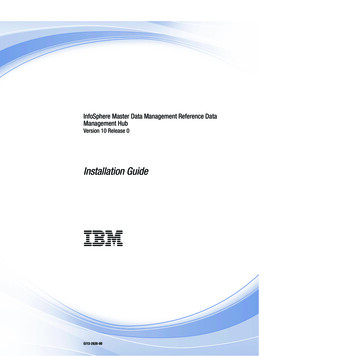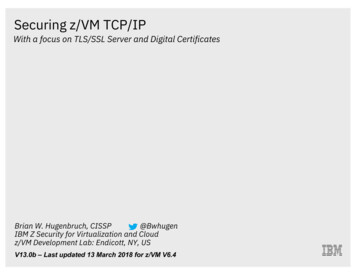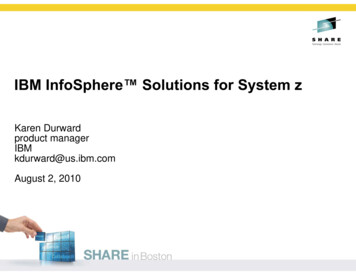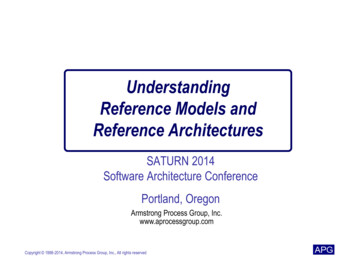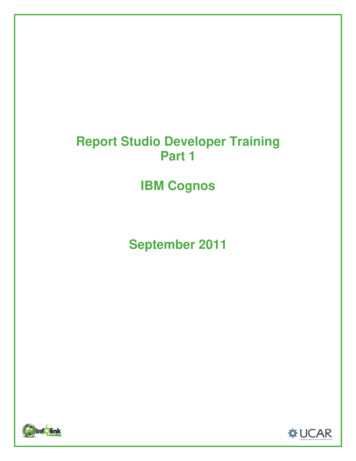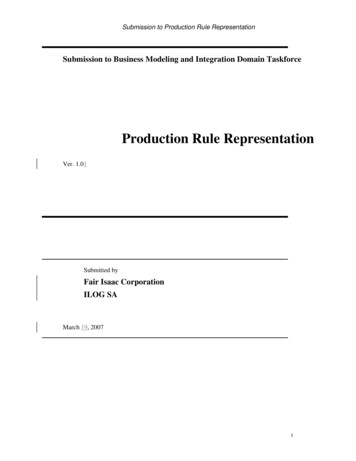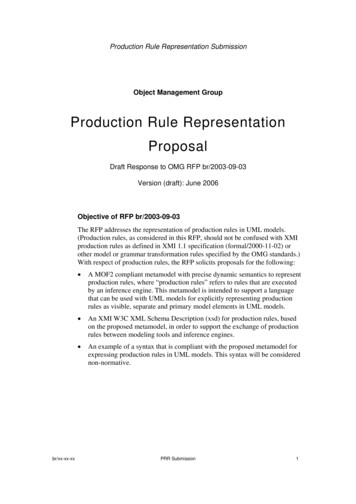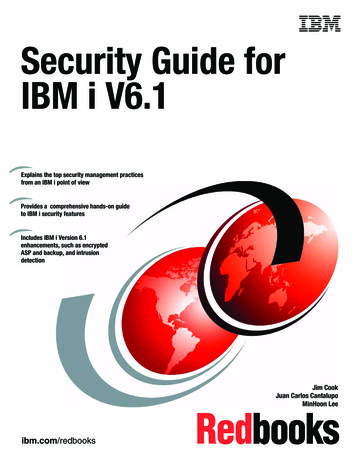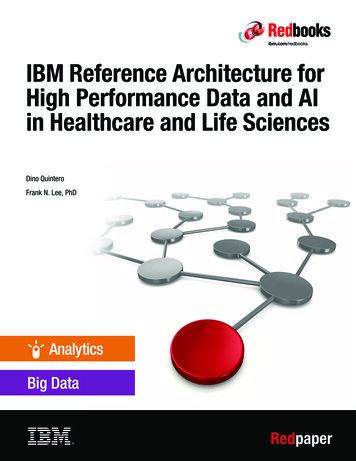
Transcription
Front coverIBM Reference Architecture forHigh Performance Data and AIin Healthcare and Life SciencesDino QuinteroFrank N. Lee, PhDRedpaper
International Technical Support OrganizationIBM Reference Architecture for High Performance Dataand AI in Healthcare and Life SciencesSeptember 2019REDP-5481-00
Note: Before using this information and the product it supports, read the information in “Notices” onpage vii.First Edition (September 2019) Copyright International Business Machines Corporation 2019. All rights reserved.Note to U.S. Government Users Restricted Rights -- Use, duplication or disclosure restricted by GSA ADP ScheduleContract with IBM Corp.
ContentsNotices . . . . . . . . . . . . . . . . . . . . . . . . . . . . . . . . . . . . . . . . . . . . . . . . . . . . . . . . . . . . . . . . . viiTrademarks . . . . . . . . . . . . . . . . . . . . . . . . . . . . . . . . . . . . . . . . . . . . . . . . . . . . . . . . . . . . . viiiPreface . . . . . . . . . . . . . . . . . . . . . . . . . . . . . . . . . . . . . . . . . . . . . . . . . . . . . . . . . . . . . . . . .Authors . . . . . . . . . . . . . . . . . . . . . . . . . . . . . . . . . . . . . . . . . . . . . . . . . . . . . . . . . . . . . . . . . .Now you can become a published author, too . . . . . . . . . . . . . . . . . . . . . . . . . . . . . . . . . . . .Comments welcome. . . . . . . . . . . . . . . . . . . . . . . . . . . . . . . . . . . . . . . . . . . . . . . . . . . . . . . .Stay connected to IBM Redbooks . . . . . . . . . . . . . . . . . . . . . . . . . . . . . . . . . . . . . . . . . . . . .ixixxixixiChapter 1. Trends and challenges for precision medicine . . . . . . . . . . . . . . . . . . . . . . .1.1 New trend: The era of precision medicine. . . . . . . . . . . . . . . . . . . . . . . . . . . . . . . . . . . .1.2 Challenges . . . . . . . . . . . . . . . . . . . . . . . . . . . . . . . . . . . . . . . . . . . . . . . . . . . . . . . . . . .1.2.1 Data management challenges . . . . . . . . . . . . . . . . . . . . . . . . . . . . . . . . . . . . . . . .1.2.2 Other data challenges . . . . . . . . . . . . . . . . . . . . . . . . . . . . . . . . . . . . . . . . . . . . . . .12335Chapter 2. The journey of the reference architecture . . . . . . . . . . . . . . . . . . . . . . . . . . . 92.1 The history of IBM Reference Architecture . . . . . . . . . . . . . . . . . . . . . . . . . . . . . . . . . . 102.1.1 First-generation reference architecture . . . . . . . . . . . . . . . . . . . . . . . . . . . . . . . . . 102.1.2 Second-generation reference architecture . . . . . . . . . . . . . . . . . . . . . . . . . . . . . . 112.2 Overview of IBM Reference Architecture for High Performance Data and AI . . . . . . . . 122.2.1 Challenges . . . . . . . . . . . . . . . . . . . . . . . . . . . . . . . . . . . . . . . . . . . . . . . . . . . . . . 122.2.2 The solution . . . . . . . . . . . . . . . . . . . . . . . . . . . . . . . . . . . . . . . . . . . . . . . . . . . . . 132.2.3 Key values . . . . . . . . . . . . . . . . . . . . . . . . . . . . . . . . . . . . . . . . . . . . . . . . . . . . . . 152.3 Datahub for High-Performance Data Analytics . . . . . . . . . . . . . . . . . . . . . . . . . . . . . . . 162.3.1 Datahub functions . . . . . . . . . . . . . . . . . . . . . . . . . . . . . . . . . . . . . . . . . . . . . . . . . 172.3.2 Datahub solution and use cases . . . . . . . . . . . . . . . . . . . . . . . . . . . . . . . . . . . . . . 192.4 Orchestrator of High-Performance Data Analytics . . . . . . . . . . . . . . . . . . . . . . . . . . . . 202.4.1 Orchestrator functions. . . . . . . . . . . . . . . . . . . . . . . . . . . . . . . . . . . . . . . . . . . . . . 202.4.2 Orchestrator solution and use cases. . . . . . . . . . . . . . . . . . . . . . . . . . . . . . . . . . . 21Chapter 3. Deployment model . . . . . . . . . . . . . . . . . . . . . . . . . . . . . . . . . . . . . . . . . . . . .3.1 Composable genomics blueprint . . . . . . . . . . . . . . . . . . . . . . . . . . . . . . . . . . . . . . . . . .3.2 IBM Software-Defined Infrastructure . . . . . . . . . . . . . . . . . . . . . . . . . . . . . . . . . . . . . . .3.3 Multicloud deployment model . . . . . . . . . . . . . . . . . . . . . . . . . . . . . . . . . . . . . . . . . . . .3.3.1 Clouds over the ocean . . . . . . . . . . . . . . . . . . . . . . . . . . . . . . . . . . . . . . . . . . . . .2324242525Chapter 4. Building blocks . . . . . . . . . . . . . . . . . . . . . . . . . . . . . . . . . . . . . . . . . . . . . . . .4.1 IBM Spectrum Storage . . . . . . . . . . . . . . . . . . . . . . . . . . . . . . . . . . . . . . . . . . . . . . . . .4.1.1 IBM Spectrum Scale . . . . . . . . . . . . . . . . . . . . . . . . . . . . . . . . . . . . . . . . . . . . . . .4.1.2 IBM Spectrum Archive . . . . . . . . . . . . . . . . . . . . . . . . . . . . . . . . . . . . . . . . . . . . .4.1.3 IBM Cloud Object Storage . . . . . . . . . . . . . . . . . . . . . . . . . . . . . . . . . . . . . . . . . .4.1.4 IBM Spectrum Discover . . . . . . . . . . . . . . . . . . . . . . . . . . . . . . . . . . . . . . . . . . . .4.2 IBM Spectrum Computing . . . . . . . . . . . . . . . . . . . . . . . . . . . . . . . . . . . . . . . . . . . . . . .4.2.1 IBM Spectrum LSF Suite . . . . . . . . . . . . . . . . . . . . . . . . . . . . . . . . . . . . . . . . . . .4.2.2 IBM Spectrum Conductor . . . . . . . . . . . . . . . . . . . . . . . . . . . . . . . . . . . . . . . . . . .4.3 IBM Power System AC922 for HPC . . . . . . . . . . . . . . . . . . . . . . . . . . . . . . . . . . . . . . .4.3.1 Accelerated computing with IBM POWER9 processor-based systems . . . . . . . .4.3.2 OpenPOWER Foundation. . . . . . . . . . . . . . . . . . . . . . . . . . . . . . . . . . . . . . . . . . .4.3.3 OpenPOWER processors . . . . . . . . . . . . . . . . . . . . . . . . . . . . . . . . . . . . . . . . . . .29303031323434343739393939 Copyright IBM Corp. 2019. All rights reserved.iii
4.3.4 Recent advancements . . . . . . . . . . . . . . . . . . . . . . . . . . . . . . . . . . . . . . . . . . . . . 404.3.5 Applications. . . . . . . . . . . . . . . . . . . . . . . . . . . . . . . . . . . . . . . . . . . . . . . . . . . . . . 40Chapter 5. Use cases . . . . . . . . . . . . . . . . . . . . . . . . . . . . . . . . . . . . . . . . . . . . . . . . . . . . 435.1 The Broad Institute Genome Analysis Toolkit (GATK) . . . . . . . . . . . . . . . . . . . . . . . . . 445.2 Expanding IBM Reference Architecture for High-Performance Data Analytics into medicalimaging . . . . . . . . . . . . . . . . . . . . . . . . . . . . . . . . . . . . . . . . . . . . . . . . . . . . . . . . . . . . . 475.2.1 Harnessing AI to transform diagnosis and treatment of brain cancer . . . . . . . . . . 475.2.2 Pushing the boundaries of traditional medicine . . . . . . . . . . . . . . . . . . . . . . . . . . 475.2.3 Diving into deep learning . . . . . . . . . . . . . . . . . . . . . . . . . . . . . . . . . . . . . . . . . . . 485.2.4 Giving physicians the tools to excel . . . . . . . . . . . . . . . . . . . . . . . . . . . . . . . . . . . 49Chapter 6. Case studies . . . . . . . . . . . . . . . . . . . . . . . . . . . . . . . . . . . . . . . . . . . . . . . . . . 516.1 Sidra Medicine . . . . . . . . . . . . . . . . . . . . . . . . . . . . . . . . . . . . . . . . . . . . . . . . . . . . . . . 526.1.1 About Sidra . . . . . . . . . . . . . . . . . . . . . . . . . . . . . . . . . . . . . . . . . . . . . . . . . . . . . . 526.1.2 The Qatar Genome Project focuses on population health and better treatments . 526.1.3 Personalized medical advances depend on having a unified view . . . . . . . . . . . . 536.1.4 Converging high-performance computing, big data, and cognitive computing . . . 536.1.5 Why cognitive computing and IBM . . . . . . . . . . . . . . . . . . . . . . . . . . . . . . . . . . . . 546.1.6 A collaboration . . . . . . . . . . . . . . . . . . . . . . . . . . . . . . . . . . . . . . . . . . . . . . . . . . . 546.1.7 Software-defined infrastructure for all data and workloads . . . . . . . . . . . . . . . . . . 546.1.8 Faster results with scalability, reliability, and speed . . . . . . . . . . . . . . . . . . . . . . . 556.1.9 Adding big data and cognitive computing to high-performance computing. . . . . . 556.1.10 Future . . . . . . . . . . . . . . . . . . . . . . . . . . . . . . . . . . . . . . . . . . . . . . . . . . . . . . . . . 566.2 Amsterdam UMC. . . . . . . . . . . . . . . . . . . . . . . . . . . . . . . . . . . . . . . . . . . . . . . . . . . . . . 566.2.1 Customer background. . . . . . . . . . . . . . . . . . . . . . . . . . . . . . . . . . . . . . . . . . . . . . 566.2.2 Business challenge . . . . . . . . . . . . . . . . . . . . . . . . . . . . . . . . . . . . . . . . . . . . . . . . 566.2.3 Transformation . . . . . . . . . . . . . . . . . . . . . . . . . . . . . . . . . . . . . . . . . . . . . . . . . . . 576.2.4 Business benefits . . . . . . . . . . . . . . . . . . . . . . . . . . . . . . . . . . . . . . . . . . . . . . . . . 576.2.5 Solution components . . . . . . . . . . . . . . . . . . . . . . . . . . . . . . . . . . . . . . . . . . . . . . 576.3 L7 Informatics . . . . . . . . . . . . . . . . . . . . . . . . . . . . . . . . . . . . . . . . . . . . . . . . . . . . . . . . 576.3.1 Customer background. . . . . . . . . . . . . . . . . . . . . . . . . . . . . . . . . . . . . . . . . . . . . . 576.3.2 Business challenge . . . . . . . . . . . . . . . . . . . . . . . . . . . . . . . . . . . . . . . . . . . . . . . . 586.3.3 Transformation . . . . . . . . . . . . . . . . . . . . . . . . . . . . . . . . . . . . . . . . . . . . . . . . . . . 586.3.4 Business benefits . . . . . . . . . . . . . . . . . . . . . . . . . . . . . . . . . . . . . . . . . . . . . . . . . 586.3.5 Solution components . . . . . . . . . . . . . . . . . . . . . . . . . . . . . . . . . . . . . . . . . . . . . . 586.4 University of Birmingham . . . . . . . . . . . . . . . . . . . . . . . . . . . . . . . . . . . . . . . . . . . . . . . 586.4.1 Customer background. . . . . . . . . . . . . . . . . . . . . . . . . . . . . . . . . . . . . . . . . . . . . . 586.4.2 Business challenge . . . . . . . . . . . . . . . . . . . . . . . . . . . . . . . . . . . . . . . . . . . . . . . . 596.4.3 Transformation . . . . . . . . . . . . . . . . . . . . . . . . . . . . . . . . . . . . . . . . . . . . . . . . . . . 596.4.4 Business benefits . . . . . . . . . . . . . . . . . . . . . . . . . . . . . . . . . . . . . . . . . . . . . . . . . 596.4.5 Solution components . . . . . . . . . . . . . . . . . . . . . . . . . . . . . . . . . . . . . . . . . . . . . . 596.5 Thomas Jefferson University. . . . . . . . . . . . . . . . . . . . . . . . . . . . . . . . . . . . . . . . . . . . . 596.5.1 Customer background. . . . . . . . . . . . . . . . . . . . . . . . . . . . . . . . . . . . . . . . . . . . . . 606.5.2 Business challenge . . . . . . . . . . . . . . . . . . . . . . . . . . . . . . . . . . . . . . . . . . . . . . . . 606.5.3 Transformation . . . . . . . . . . . . . . . . . . . . . . . . . . . . . . . . . . . . . . . . . . . . . . . . . . . 606.5.4 Business benefits . . . . . . . . . . . . . . . . . . . . . . . . . . . . . . . . . . . . . . . . . . . . . . . . . 606.5.5 Solution components . . . . . . . . . . . . . . . . . . . . . . . . . . . . . . . . . . . . . . . . . . . . . . 606.6 Biotechnology and Biomedicine Center of the Czech Academy of Sciences and CharlesUniversity: BIOCEV . . . . . . . . . . . . . . . . . . . . . . . . . . . . . . . . . . . . . . . . . . . . . . . . . . . 616.6.1 Customer background. . . . . . . . . . . . . . . . . . . . . . . . . . . . . . . . . . . . . . . . . . . . . . 616.6.2 Business challenge . . . . . . . . . . . . . . . . . . . . . . . . . . . . . . . . . . . . . . . . . . . . . . . . 616.6.3 Transformation . . . . . . . . . . . . . . . . . . . . . . . . . . . . . . . . . . . . . . . . . . . . . . . . . . . 61ivIBM Reference Architecture for High Performance Data and AI in Healthcare and Life Sciences
6.6.4 Business benefits . . . . . . . . . . . . . . . . . . . . . . . . . . . . . . . . . . . . . . . . . . . . . . . . .6.6.5 Solution components . . . . . . . . . . . . . . . . . . . . . . . . . . . . . . . . . . . . . . . . . . . . . .6.7 Washington University St. Louis and Vanderbilt University. . . . . . . . . . . . . . . . . . . . . .6.7.1 Customer background. . . . . . . . . . . . . . . . . . . . . . . . . . . . . . . . . . . . . . . . . . . . . .6.7.2 Business challenge . . . . . . . . . . . . . . . . . . . . . . . . . . . . . . . . . . . . . . . . . . . . . . . .6.7.3 Transformation . . . . . . . . . . . . . . . . . . . . . . . . . . . . . . . . . . . . . . . . . . . . . . . . . . .6.7.4 Business benefits . . . . . . . . . . . . . . . . . . . . . . . . . . . . . . . . . . . . . . . . . . . . . . . . .6.7.5 Solution components . . . . . . . . . . . . . . . . . . . . . . . . . . . . . . . . . . . . . . . . . . . . . .6161626262626263Appendix A. Profiling GATK . . . . . . . . . . . . . . . . . . . . . . . . . . . . . . . . . . . . . . . . . . . . . . 65Related publications . . . . . . . . . . . . . . . . . . . . . . . . . . . . . . . . . . . . . . . . . . . . . . . . . . . . .IBM Redbooks . . . . . . . . . . . . . . . . . . . . . . . . . . . . . . . . . . . . . . . . . . . . . . . . . . . . . . . . . . .Online resources . . . . . . . . . . . . . . . . . . . . . . . . . . . . . . . . . . . . . . . . . . . . . . . . . . . . . . . . .Help from IBM . . . . . . . . . . . . . . . . . . . . . . . . . . . . . . . . . . . . . . . . . . . . . . . . . . . . . . . . . . .Contents71717172v
viIBM Reference Architecture for High Performance Data and AI in Healthcare and Life Sciences
NoticesThis information was developed for products and services offered in the US. This material might be availablefrom IBM in other languages. However, you may be required to own a copy of the product or product version inthat language in order to access it.IBM may not offer the products, services, or features discussed in this document in other countries. Consultyour local IBM representative for information on the products and services currently available in your area. Anyreference to an IBM product, program, or service is not intended to state or imply that only that IBM product,program, or service may be used. Any functionally equivalent product, program, or service that does notinfringe any IBM intellectual property right may be used instead. However, it is the user’s responsibility toevaluate and verify the operation of any non-IBM product, program, or service.IBM may have patents or pending patent applications covering subject matter described in this document. Thefurnishing of this document does not grant you any license to these patents. You can send license inquiries, inwriting, to:IBM Director of Licensing, IBM Corporation, North Castle Drive, MD-NC119, Armonk, NY 10504-1785, USINTERNATIONAL BUSINESS MACHINES CORPORATION PROVIDES THIS PUBLICATION “AS IS”WITHOUT WARRANTY OF ANY KIND, EITHER EXPRESS OR IMPLIED, INCLUDING, BUT NOT LIMITEDTO, THE IMPLIED WARRANTIES OF NON-INFRINGEMENT, MERCHANTABILITY OR FITNESS FOR APARTICULAR PURPOSE. Some jurisdictions do not allow disclaimer of express or implied warranties incertain transactions, therefore, this statement may not apply to you.This information could include technical inaccuracies or typographical errors. Changes are periodically madeto the information herein; these changes will be incorporated in new editions of the publication. IBM may makeimprovements and/or changes in the product(s) and/or the program(s) described in this publication at any timewithout notice.Any references in this information to non-IBM websites are provided for convenience only and do not in anymanner serve as an endorsement of those websites. The materials at those websites are not part of thematerials for this IBM product and use of those websites is at your own risk.IBM may use or distribute any of the information you provide in any way it believes appropriate withoutincurring any obligation to you.The performance data and client examples cited are presented for illustrative purposes only. Actualperformance results may vary depending on specific configurations and operating conditions.Information concerning non-IBM products was obtained from the suppliers of those products, their publishedannouncements or other publicly available sources. IBM has not tested those products and cannot confirm theaccuracy of performance, compatibility or any other claims related to non-IBM products. Questions on thecapabilities of non-IBM products should be addressed to the suppliers of those products.Statements regarding IBM’s future direction or intent are subject to change or withdrawal without notice, andrepresent goals and objectives only.This information contains examples of data and reports used in daily business operations. To illustrate themas completely as possible, the examples include the names of individuals, companies, brands, and products.All of these names are fictitious and any similarity to actual people or business enterprises is entirelycoincidental.COPYRIGHT LICENSE:This information contains sample application programs in source language, which illustrate programmingtechniques on various operating platforms. You may copy, modify, and distribute these sample programs inany form without payment to IBM, for the purposes of developing, using, marketing or distributing applicationprograms conforming to the application programming interface for the operating platform for which the sampleprograms are written. These examples have not been thoroughly tested under all conditions. IBM, therefore,cannot guarantee or imply reliability, serviceability, or function of these programs. The sample programs areprovided “AS IS”, without warranty of any kind. IBM shall not be liable for any damages arising out of your useof the sample programs. Copyright IBM Corp. 2019. All rights reserved.vii
TrademarksIBM, the IBM logo, and ibm.com are trademarks or registered trademarks of International Business MachinesCorporation, registered in many jurisdictions worldwide. Other product and service names might betrademarks of IBM or other companies. A current list of IBM trademarks is available on the web at “Copyrightand trademark information” at http://www.ibm.com/legal/copytrade.shtmlThe following terms are trademarks or registered trademarks of International Business Machines Corporation,and might also be trademarks or registered trademarks in other countries.Accesser IBM IBM Elastic Storage IBM Spectrum IBM Spectrum Conductor IBM Watson LSF POWER Power Architecture POWER8 Redbooks Redbooks (logo)Slicestor Storwize Tivoli The following terms are trademarks of other companies:Veracity, are trademarks or registered trademarks of Merge Healthcare Inc., an IBM Company.Linux is a trademark of Linus Torvalds in the United States, other countries, or both.Microsoft, Windows, and the Windows logo are trademarks of Microsoft Corporation in the United States,other countries, or both.Java, and all Java-based trademarks and logos are trademarks or registered trademarks of Oracle and/or itsaffiliates.Other company, product, or service names may be trademarks or service marks of others.viiiIBM Reference Architecture for High Performance Data and AI in Healthcare and Life Sciences
PrefaceThis IBM Redpaper publication provides an update to the original description of IBMReference Architecture for Genomics. This paper expands the reference architecture to coverall of the major vertical areas of healthcare and life sciences industries, such as genomics,imaging, and clinical and translational research.The architecture was renamed IBM Reference Architecture for High Performance Data andAI in Healthcare and Life Sciences to reflect the fact that it incorporates key building blocks forhigh-performance computing (HPC) and software-defined storage, and that it supports anexpanding infrastructure of leading industry partners, platforms, and frameworks.The reference architecture defines a highly flexible, scalable, and cost-effective platform foraccessing, managing, storing, sharing, integrating, and analyzing big data, which can bedeployed on-premises, in the cloud, or as a hybrid of the two. IT organizations can use thereference architecture as a high-level guide for overcoming data management challenges andprocessing bottlenecks that are frequently encountered in personalized healthcare initiatives,and in compute-intensive and data-intensive biomedical workloads.This reference architecture also provides a framework and context for modern healthcare andlife sciences institutions to adopt cutting-edge technologies, such as cognitive life sciencessolutions, machine learning and deep learning, Spark for analytics, and cloud computing. Toillustrate these points, this paper includes case studies describing how clients and IBMBusiness Partners alike used the reference architecture in the deployments of demandinginfrastructures for precision medicine.This publication targets technical professionals (consultants, technical support staff, ITArchitects, and IT Specialists) who are responsible for providing life sciences solutions andsupport.AuthorsThis paper was produced by a team of specialists from around the world working at theInternational Technical Support Organization (ITSO), Poughkeepsie Center.Dino Quintero is an IT Management Consultant and an IBM Level 3 Senior Certified ITSpecialist with the IBM Redbooks team in Poughkeepsie, New York. Dino shares histechnical computing passion and expertise by leading teams developing technical content inthe areas of enterprise continuous availability, enterprise systems management,high-performance computing, cloud computing, artificial intelligence (including machine anddeep learning), and cognitive solutions. He is also a Certified Open Group Distinguished ITSpecialist. Dino holds a Master of Computing Information Systems degree and a Bachelor ofScience degree in Computer Science from Marist College. Copyright IBM Corp. 2019. All rights reserved.ix
Frank N. Lee, PhD Dr. Frank Lee is the healthcare and life sciences industry leader for IBMSystems Group with over twenty years’ experience in scientific research and informationtechnology. His work includes the creation of industry reference architecture and itsimplementation as HPC, cloud, big data, and AI platforms for dozens of clients and IBMBusiness Partners worldwide. As an advocate for the transformation of the industry towardsprecision medicine, Frank has spoken in dozens of conferences and published in IBMSystems Journals, IBM Redbooks publications, research papers, HPCwire editorials, andHIMSS reports. When encountering gaps in technologies, Frank led charges of innovationwith inventions in metadata and provenance management as a co-inventor of IBM Spectrum Discover software and underlying technologies. Frank also provides subject matter expertiseon genomics, an experience that includes participation in the Human Genome Project as aresearch associate and his training as a molecular biologist at Washington University.Special acknowledgment to the following for their contributions to this project:We thank the Sidra technical team for their leadership and contribution to the IBM-Sidracollaboration. We also thank Sidra Communications and the IBM Qatar team for producingand publishing reference materials, including press releases, videos, and media stories. Wethank other clients and partners from Washington University Genome Center, NorthwesternUniversity Medical Center, and others, for their collaboration in and contribution todevelopment for the reference architecture.Thanks to the following people for their contributions to this project:Wade WallaceInternational Technical Support Organization, Poughkeepsie CenterLinda Cham, Ruzhu Chen, Jeff Hong, Denise Ruffner, David Wohlford, Joanna Wong,Jane YuIBM USBill McMillan, Richard WaleIBM UKJeff Karmiol, Gabor SamuIBM CanadaYael ShaniIBM IsraelxIBM Reference Architecture for High Performance Data and AI in Healthcare and Life Sciences
Now you can become a published author, tooHere’s an opportunity to spotlight your skills, grow your career, and become a publishedauthor—all at the same time. Join an ITSO residency project and help write a book in yourarea of expertise, while honing your experience using leading-edge technologies. Your effortswill help to increase product acceptance and customer satisfaction, as you expand yournetwork of technical contacts and relationships. Residencies run from two to six weeks inlength, and you can participate either in person or as a remote resident working from yourhome base.Find out more about the residency program, browse the residency index, and apply online:ibm.com/redbooks/residencies.htmlComments welcomeYour comments are important to us.We want our papers to be as helpful as possible. Send us your comments about this paper orother IBM Redbooks publications in one of the following ways: Use the online Contact us review Redbooks form:ibm.com/redbooks Send your comments in an email:redbooks@us.ibm.com Mail your comments:IBM Corporation, International Technical Support OrganizationDept. HYTD Mail Station P0992455 South RoadPoughkeepsie, NY 12601-5400Stay connected to IBM Redbooks Find us on Facebook:http://www.facebook.com/IBMRedbooks Follow us on Twitter:http://twitter.com/ibmredbooks Look for us on LinkedIn:http://www.linkedin.com/groups?home &gid 2130806 Explore new Redbooks publications, residencies, and workshops with the IBM Redbooksweekly sf/subscribe?OpenForm Stay current on recent Redbooks publications with RSS i
xiiIBM Reference Architecture for High Performance Data and AI in Healthcare and Life Sciences
1Chapter 1.Trends and challenges forprecision medicineAccelerating personalized healthcare and other biomedical workloads requires the adoptionof cost-effective, high-performance infrastructure for big data analytics and artificialintelligence. Healthcare and life sciences organizations worldwide must manage, access,store, share, and analyze an explosive amount of data within the constraints of their ITbudgets. IBM reference architecture for high-performance data analytics for healthcare andlife sciences defines a platform for delivering the highest levels of performance for big dataworkloads at the same time lowering the total cost of ownership (TCO) for IT.Advancements in high-throughput molecular profiling techniques and high-performancecomputing (HPC) systems ushered in a new era of personalized medicine. In personalizedmedicine, the treatment and prevention of disease can be tailored to the unique molecularprofiles, behavioral characteristics, and environmental exposures of individual patients.Discovering treatment plans that are tailored to specific patient populations requires a clearunderstanding of the impact that such factors are likely to have on clinical outcomes.Moreover, the task of delivering those plans in a time-sensitive clinical setting requirestechnical computing platforms that quickly and accurately classify individual patients intotreatment cohorts most likely to achieve favorable outcomes in a timely manner. Suchresearch and clinical tasks require healthcare and life science practitioners to access,process, and analyze various complex, information-rich data sources.This chapter provides an overview of the IBM Reference Architecture for High PerformanceData and AI in Healthcare and Life Sciences.This chapter contains the following topics: New trend: The era of precision medicine Challenges Copyright IBM Corp. 2019. All rights reserved.1
1.1 New trend: The era of precision medicineAdvancing the science of medicine by targeting a disease more precisely with treatment thatis specific to each patient relies on access to that patient’s genomics information and theability to process massive amounts of genomics data quickly. The following trends are factorsfor this era of precision medicine: Data-drivenAdvances in precision medicine, genomics, and imaging, along with widespread adoptionof electronic health records and the proliferation of medical internet of things (IoT) andmobile devices, are resulting in an exponential growth of structured and unstructured data:– By the end of 2020, 25% of data that is used in medical care will be collected andshared with healthcare systems by the patients themselves (“bring your own data”).1– Healthcare providers have fully embraced the IoT, with 72.7% of respondents havingdeployed an IoT solution and the remainder piloting or researching using IoT.2 Pervasive artificial or augmented intelligence (AI)To glean actionable insights from these large and complex data sets, healthcareorganizations are investing in high-performance systems that support AI workloads. Mostof the investment started in the research areas such as bioinformatics, computationalchemistry, cellular imaging and natural language processing but started to spread intoclinical areas such as medical imaging and informatics.The AI workflow also requires or intersects with traditional workloads such as highperformance and accelerated computing, machine learning, biostatistics, medicalanalytics and clinical informatics. This trend creates huge challenges on healthcareinfrastructure and most institutions cannot keep up with the pace of change andcomplexities. MulticloudForward-thinking healthcare organizations are modernizing their infrastructure bydeploying data-driven, multicloud storage and software-defined infrastructure because itensures the highest level of data availability, reliability, and cost-efficiency. The benefits ofstorage and software-defined infrastructure accrue not only to IT,
accessing, managing, storing, sharing, integrating, and analyzing big data, which can be deployed on-premises, in the cloud, or as a hybrid of the two. IT organizations can use the reference architecture as a high-level guide fo r o

